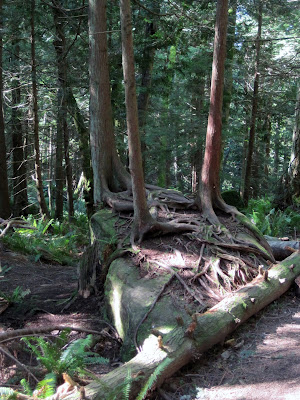with no shoulders
and rock faces that jut out from your right
and a drop off to your left.
It make you think reaaaaal skinny thoughts.
Today made more fun with the presence of bikes on a road race / event. Fast bikes and slow bikes. Bikes not staying on their side of the fog line.
But I went to Larrabee knowing that it, like Washington Park, is situated on a scoured off rock face overlooking Strait of Georgia / Juan de Fuca. It is under the slim influence of the rain shadow, just like Washington Park to the southwest. I was hoping to find some unique plant life.
I also have a new pair of hiking shoes to try out. This park presents a nice steady climbing grade that will give them (and me) a good trial. Not as steep with distance as Umtanum, but a good 1000 gain in 1 1/2 mile.
I found, when I arrived, that there was a 50K ultra run going on. Yes 50 Km through the woods over hill and dale, stumbling rocks, roots and some pretty steep hills. It takes them up to 8 hours to run the course. I had a nice chat with a fellow manning one of the resource stations. He was alone and made use of his idle time by moving old bridge planks from a pile in the woods to the back of his pick up truck. Volunteers, you got to love them.
This park is known for its fossil deposits near the beach. I did not visit them, but yet again have another "to do" on my list. Inside the woods you often come upon sudden rock outcrops and cliff faces that show where glaciers of the Ice Age carves out the inland sea and its islands.
Rock like this holds little top soil and usually supports a unique population of plants. Today I found Maidenhair Fern. They like rock and humus, certainly not a common thing in my homeland of central Puget Sound.

I also found Deer Fern fiddleheads. I have never seen them this fresh. They made a pretty picture.

The prize of the day was the Striped Coralroot. These are related to the spotted Coralroot I find at Washington Park. I did find a few Spotted, but today the Striped orchids were the winner.


Today is Migratory Bird Day and I certainly heard plenty of our seasonal visitors. Wilson's and Townsend's warblers, Black Headed Grossbeak, Warbling Verio and Rufous Hummingbird. I had not yet heard Rufus Hummingbird this year, not even at feeders. I saw an item earlier that there is concern that the Washington population has seen a decline for unknown reason. In my common areas, it seems true.
I took a spur trail to the overlook because on a day like this, there is plenty to see.

I love this trio of trees growing on an erratic. I inspected closely and there is no longer any soil on the boulder. The roots extend over the rock to the ground and onto the soil. Magnificent.

There are several places where I would feel slightly spooked to be in an earthquake or huge wind storm. Look at how some of these very large trees cling to the edges of the rock face.

Typical western lowland flowers are in bloom. Here Trillium are still holding on. Most of them are just starting to turn their purple hues.

Bleeding heart fill in the edges here and there.

I have never spotted little mushrooms like these. Not sure if they are safe, I suspect not just based on color.

I cannot believe we have another beautiful day ahead.
Holy Smokes! Those roots extending over the rocks are a sight to behold. And, the striped coralroot is beautiful. Wasn't I reading somewhere that coralroot is pretty rare? Or, am I mixing that up with something else?
ReplyDeleteI am not sure of your Reference Louise.
ReplyDeleteAll the orchids are uncommon in that they have very specific and intimate growing conditions. They need their specific fungi in the soil to grow on and often those depend on their host tree or plant. They are not always annual and very sensitive to disruption.
I am currently finding them in some of the environments I go to. These are areas of well drained shallow soil with moderate sunlight and very little understory. When the conditions are right I might find a few plants.
Sunday I went to a state park because someone clued me in on the presence of some particular plants. I found two populations of orchid that were tightly confined to very particular spots. I learned later from the advisor that I had missed a third population group. Add the issue of their size ( usually somewhat small) and color ( well blended) and seeing them can be a challenge.
It may be that they are more common than not, it is just in the learning how to see them. I certainly agree that this is a case in many things. I found it very true when learning birds.
I am going on a field trip with the Wild Orchid Society at the end of the month. I am hoping to learn more about the environment and culture needs of saphrophytes. Plants like Candystick, Indian Pipe, Pine drops and Groundcone ( the one I looked for last Sunday)
Plus it will be a chance to get into the mountains. My hike this coming Saturday was cancelled due to late season snow
At least we have enough snow pack for irrigation now.
Thanks so much for visiting my blog all the way over in Africa ! I'm glad to have found yours, too .... your photo's are magnificent !
ReplyDeleteBye for now
Lynda, Kilimanjaro, East Africa